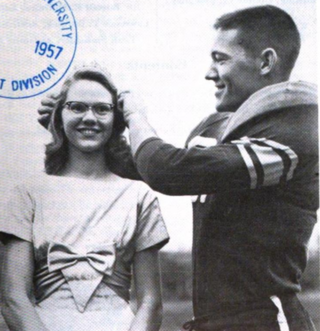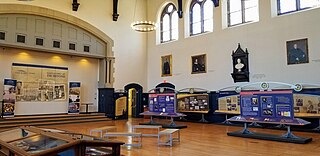
William Clarence “Bill” Stokoe Jr. was an American linguist and a long-time professor at Gallaudet University. His research on American Sign Language (ASL) revolutionized the understanding of ASL in the United States and sign languages throughout the world. Stokoe's work led to a widespread recognition that sign languages are true languages, exhibiting syntax and morphology, and are not only systems of gesture.

Gallaudet University is a private federally chartered university in Washington, D.C., for the education of the deaf and hard of hearing. It was founded in 1864 as a grammar school for both deaf and blind children. It was the first school for the advanced education of the deaf and hard of hearing in the world and remains the only higher education institution in which all programs and services are specifically designed to accommodate deaf and hard of hearing students. Hearing students are admitted to the graduate school and a small number are also admitted as undergraduates each year. The university was named after Thomas Hopkins Gallaudet, a notable figure in the advancement of deaf education.

Edward Miner Gallaudet, was the first president of Gallaudet University in Washington, D.C. from 1864 to 1910.
Irving King Jordan is an American educator who became the first deaf president of Gallaudet University in 1988 after the Deaf President Now protest. Gallaudet is the world's only university with all programs and services designed specifically for deaf and hard-of-hearing students.

Deaf President Now (DPN) was a student protest in March 1988 at Gallaudet University, Washington, D.C. The protest began on March 6, 1988, when the Board of Trustees announced its decision to appoint a hearing candidate, Elizabeth Zinser, over the other Deaf candidates, Irving King Jordan and Harvey Corson, as its seventh president.
Harvey J. Corson, Ed.D., was the executive director for the American School for the Deaf in West Hartford, Connecticut. He announced his retirement in 2006, ending his term as executive director, a post he held at the American School for the Deaf since 2001.
The National Association of the Deaf (NAD) is an organization for the promotion of the rights of deaf people in the United States. NAD was founded in Cincinnati, Ohio, in 1880 as a non-profit organization run by Deaf people to advocate for deaf rights, its first president being Robert P. McGregor of Ohio. It includes associations from all 50 states and Washington, DC, and is the US member of the World Federation of the Deaf, which has over 120 national associations of Deaf people as members. It has its headquarters in Silver Spring, Maryland.

Jane Fernandes is an American educator and social justice advocate. As of August 2021, Fernandes is the President of Antioch College in Yellow Springs, Ohio. She previously served as president of Guilford College from 2014 to 2021.

The Ohio School for the Deaf is a school located in Columbus, Ohio. It is run by the Ohio Department of Education for deaf and hard-of-hearing students across Ohio. It was established on October 16, 1829, making it the fifth oldest residential school in the country. OSD is the only publicly funded residential school for the deaf in Ohio.
Dr. Robert Davila served as the ninth president of Gallaudet University, the world's only university in which all programs and services are specifically designed to accommodate deaf and hard of hearing students. His appointment came after the wake of the Unity for Gallaudet Movement protests of 2006, when many students, staff, and alumni objected to the initial choice of Jane Fernandes as the intended next president. It was originally intended that he serve only 18–24 months as an interim president, but the Board dropped the interim designation and then extended his contract to 36 months.
Gallaudet University Press (GUPress) is a publisher that focuses on issues relating to deafness and sign language. It is a part of Gallaudet University in Washington D.C., and was founded in 1980 by the university's board of trustees. The press is a member of the Association of University Presses. The press publishes two quarterly journals: American Annals of the Deaf and Sign Language Studies.
Elisabeth Ann Zinser is a retired university president, most recently at Southern Oregon University (2001–06) in Ashland, Oregon. Previously she was the chancellor of the Lexington campus of the University of Kentucky (1995–2001), and the first female president of the University of Idaho, serving from 1989–95 in Moscow, Idaho.
Jerry C. Lee was the sixth president of Gallaudet University from 1984 to 1988, later becoming the President of National University in La Jolla, California from 1989 to 2001 and Chancellor of the reorganized National University System from 2001 to 2013.
The history of deaf education in the United States began in the early 1800s when the Cobbs School of Virginia, an oral school, was established by William Bolling and John Braidwood, and the Connecticut Asylum for the Deaf and Dumb, a manual school, was established by Thomas Hopkins Gallaudet and Laurent Clerc. When the Cobbs School closed in 1816, the manual method, which used American Sign Language, became commonplace in deaf schools for most of the remainder of the century. In the late 1800s, schools began to use the oral method, which only allowed the use of speech, as opposed to the manual method previously in place. Students caught using sign language in oral programs were often punished. The oral method was used for many years until sign language instruction gradually began to come back into deaf education.

The Deaf rights movement encompasses a series of social movements within the disability rights and cultural diversity movements that encourages deaf and hard of hearing to push society to adopt a position of equal respect for them. Acknowledging that those who were Deaf or hard of hearing had rights to obtain the same things as those hearing lead this movement. Establishing an educational system to teach those with Deafness was one of the first accomplishments of this movement. Sign language, as well as cochlear implants, has also had an extensive impact on the Deaf community. These have all been aspects that have paved the way for those with Deafness, which began with the Deaf Rights movement.
Kendall Demonstration Elementary School (KDES) is a private day school serving deaf and hard of hearing students from birth through grade 8 on the campus of Gallaudet University in the Trinidad neighborhood of Washington, D.C. Alongside Model Secondary School for the Deaf, it is a federally funded, tuition-free demonstration school administered by the Laurent Clerc National Deaf Education Center at Gallaudet University.
Gertrude Scott Galloway was an American educator and administrator working with deaf children. She was the first female president of the National Association of the Deaf. She is among the first deaf women to head a school for the deaf in the United States. Galloway was an advocate for deaf women throughout her life.

Jack Randle Gannon was an American author and historian of Deaf culture. Deaf since age eight, he had chronicled the history and culture of Deaf people and organizations around the world, most notably in his 1981 book Deaf Heritage. Gannon was an educator at the Nebraska School for the Deaf and served for many years in administrative roles at Gallaudet University.
Roslyn "Roz" Goodstein Rosen is an American advocate for the Deaf community. Rosen was the president of the National Association of the Deaf from 1990 to 1993 and was a board member for the World Federation of the Deaf from 1995 to 2003. She served in multiple academic administrator roles throughout her career, including as the Vice President for Academic Affairs at Gallaudet University, and was the director of the National Center on Deafness from 2006 to 2014.

The National Deaf Life Museum is a museum focusing on the culture and history of deaf and hard of hearing people in the United States. Founded in 2007 as the Gallaudet University Museum, the museum is operated by Gallaudet University and located on the school's campus in Washington, D.C. The museum formally opened in 2014 and changed its name to the National Deaf Life Museum in 2019.








